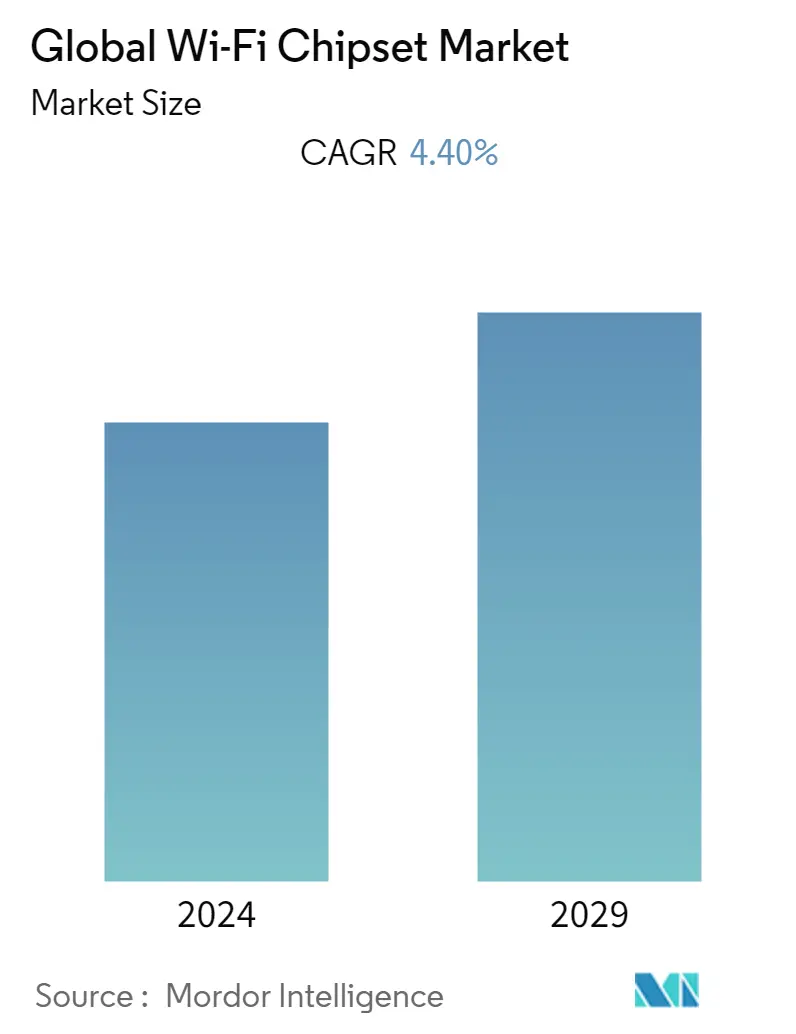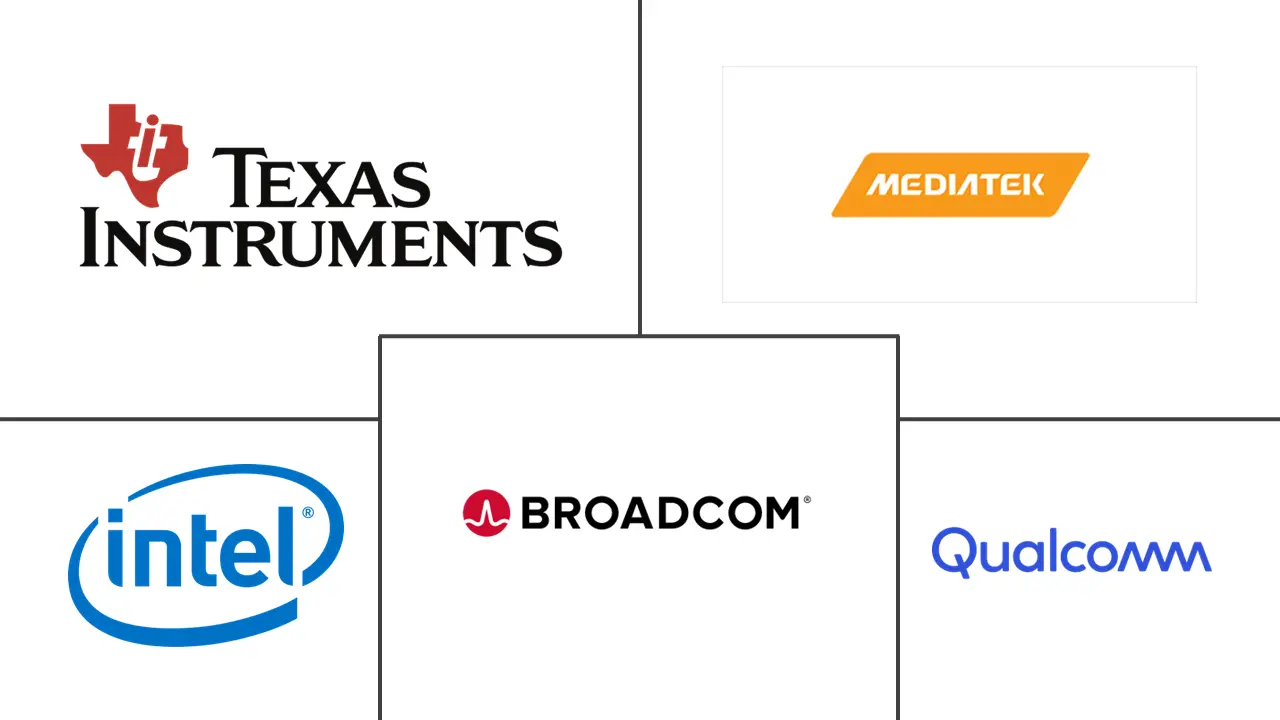Market Size of Global Wi-Fi Chipset Industry

| Study Period | 2019 - 2029 |
| Base Year For Estimation | 2023 |
| CAGR | 4.40 % |
| Fastest Growing Market | Asia-Pacific |
| Largest Market | North America |
| Market Concentration | Medium |
Major Players
*Disclaimer: Major Players sorted in no particular order |
Wi-Fi Chipset Market Analysis
The Global Wi-Fi Chipset Market is expected to grow at a CAGR of 4.4% during the forecasted period of 2022 to 2027. Due to the growing popularity of smartphones worldwide, Wi-Fi technology has increased usage. Furthermore, governments worldwide are building smart cities with public Wi-Fi networks to help service industries, such as education and healthcare. These factors increase Wi-Fi usage in homes, offices, and public spaces, increasing Wi-Fi chipset sales. Customers prefer Voice-Over Mobile Broadband (VOMBB) over traditional telecom carriers because of its great audio quality, lower cost, and ability to save power, fueling demand for Wi-Fi services worldwide.
- According to the Organisation for Economic Co-operation and Development survey, By 2025, the number of households having a computer is expected to increase to 1,262.47 million. Homes with at least one computer are referred to as computer households. Such a huge increase in computer adoption will create aopportunity for the market players to expand their Wi-Fi chipset product portfolio, expand their presence in different regions, and increase their market share.
- Consumers focus on the value of information as the number of connected devices grows exponentially. Many people have multiple sources of information and are increasingly reliant on mobile devices and the Internet. Through Facebook pages, e-mails, and location-based marketing, retailers see the benefit of supporting customers in gathering information and building customer relationship management systems. Furthermore, merchants are increasingly using in-store Wi-Fi to engage with customers and enable them to make purchasing decisions. Consumers shopping habits have shifted as a result of mobile devices. Mobile users read options and reviews, check a retailer's product availability, access interactive store maps, view discounts and loyalty offers, and make online purchases using mobile devices.
- According to a report from Snapchat, by 2025, around 75% of the global population and almost all smartphone users will be frequent AR technology users, out of which more than 1.5 billion are anticipated to be millennials. According to GSMA's Mobile Economy China 2021, China will be adding around 340 million smartphone connections by 2025, with adoption rising to 9 in 10 connections with 1.5 billion in Mainland China, 12.3 million in Hong Kong, 1.9 million in Macao, and 25.7 million in Taiwan.
- The increasing activities of cyber criminals successfully penetrating and moving laterally within the security perimeter are expected to increase privacy concerns. Organizations relying solely on on-premises firewalls and VPNs lack the visibility solution integration and agility to deliver timely end-to-end security coverage. As evidence, large-scale, multi-vector mega attacks are growing, wreaking havoc on organizations and individuals worldwide.
- However, according to the Semiconductor Industry Association, after Q1 of 2020, the semiconductor industry started the recovery in line with the global demand for electronics such as laptops and desktops for the growing trend of Work from Home. Despite logistical challenges related to the coronavirus, semiconductor facilities in Asia-Pacific usually function with high-capacity rates. Moreover, most semiconductor operations in various countries, such as South Korea, continued uninterrupted, and chip exports grew by 9.4% in February 2020.
Wi-Fi Chipset Industry Segmentation
A Wi-Fi chipset is a piece of internal hardware that allows wireless communication systems or computers to communicate with other wireless devices. Wi-Fi chipsets are used in hardware components such as external wireless local area network (WLAN) cards or WLAN adapters. The Global Wi-Fi Chipset market is segmented by Protocol Type ( 802.11ac, 802.11n, 802.11ax, 802.11b), by MIMO configuration ( MU-MIMO, SU-MIMO), by Application (Residential, Enterprise, Education, Government, and Public Utilities) and Geography.
| By Protocol Type | |
| 802.11ac | |
| 802.11n | |
| 802.11ax | |
| 802.11b | |
| Others |
| BY MIMO Configuration | |
| MU-MIMO | |
| SU-MIMO |
| By Application | |
| Residential | |
| Enterprise | |
| Education | |
| Government and Public Utilites | |
| Others |
| By Geography | |||||||
| |||||||
| |||||||
| |||||||
| Rest of the World |
Global Wi-Fi Chipset Market Size Summary
The Wi-Fi chipset market is poised for steady growth, driven by the increasing adoption of smartphones and the expansion of smart city initiatives worldwide. The demand for Wi-Fi technology is bolstered by its integration into various sectors such as education, healthcare, and retail, where it enhances connectivity and customer engagement. The shift towards Voice-Over Mobile Broadband (VOMBB) due to its superior audio quality and cost-effectiveness further propels the market. As more households acquire computers and connected devices, the opportunity for market players to expand their product offerings and regional presence becomes significant. The proliferation of mobile devices has transformed consumer shopping habits, with in-store Wi-Fi playing a crucial role in facilitating informed purchasing decisions.
The market landscape is characterized by moderate concentration, with key players like Broadcom, Qualcomm, and MediaTek investing in innovative Wi-Fi solutions to meet evolving consumer demands. The introduction of advanced standards such as Wi-Fi 6 and the upcoming Wi-Fi 7, along with strategic partnerships and acquisitions, underscores the competitive dynamics of the industry. The integration of Wi-Fi technology in IoT applications, particularly in sectors like smart manufacturing and healthcare, presents further growth avenues. Despite challenges such as cybersecurity threats and logistical issues, the market is expected to benefit from the recovery of the semiconductor industry and the increasing adoption of 5G technology, particularly in regions like North America and Latin America.
Global Wi-Fi Chipset Market Size - Table of Contents
-
1. MARKET INSIGHTS
-
1.1 Market Overview
-
1.2 Industry Attractiveness - Porter's Five Forces Analysis
-
1.2.1 Bargaining Power Of Suppliers
-
1.2.2 Bargaining Power Of Buyers
-
1.2.3 Threat Of New Entrants
-
1.2.4 Threat Of Substitutes
-
1.2.5 Intensity Of Competitive Rivalry
-
-
1.3 Value Chain Analysis
-
1.4 Assessment of the Impact of Covid-19 on the Market
-
-
2. MARKET SEGMENTATION
-
2.1 By Protocol Type
-
2.1.1 802.11ac
-
2.1.2 802.11n
-
2.1.3 802.11ax
-
2.1.4 802.11b
-
2.1.5 Others
-
-
2.2 BY MIMO Configuration
-
2.2.1 MU-MIMO
-
2.2.2 SU-MIMO
-
-
2.3 By Application
-
2.3.1 Residential
-
2.3.2 Enterprise
-
2.3.3 Education
-
2.3.4 Government and Public Utilites
-
2.3.5 Others
-
-
2.4 By Geography
-
2.4.1 North America
-
2.4.1.1 United States
-
2.4.1.2 Canada
-
-
2.4.2 Europe
-
2.4.2.1 United Kingdom
-
2.4.2.2 Germany
-
2.4.2.3 France
-
2.4.2.4 Rest of Europe
-
-
2.4.3 Asia-Pacific
-
2.4.3.1 China
-
2.4.3.2 South Korea
-
2.4.3.3 Japan
-
2.4.3.4 India
-
2.4.3.5 Rest of Asia-Pacifc
-
-
2.4.4 Rest of the World
-
-
Global Wi-Fi Chipset Market Size FAQs
What is the current Global Wi-Fi Chipset Market size?
The Global Wi-Fi Chipset Market is projected to register a CAGR of 4.40% during the forecast period (2024-2029)
Who are the key players in Global Wi-Fi Chipset Market?
Qualcomm, Broadcom, Mediatek, Intel Corporation and Texas Instruments Incorporated are the major companies operating in the Global Wi-Fi Chipset Market.

